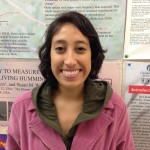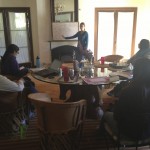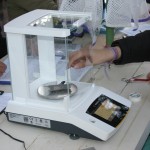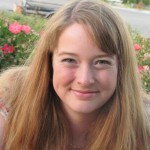The lab packed up some of our results from this past year’s research and headed off to the SICB meeting in San Francisco to share them with national and international colleagues from across the globe. Our work attracted a great deal of attention this year and the students did a wonderful job of exciting our colleagues about what we have been doing.
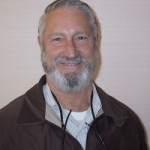
The first full day of the meeting was action packed! The morning started with a special symposium in honor of the lifetime work of Ken Nagy (pictured), who in the 1970’s developed protocols for using the doubly-labeled water (DLW) technique to measure energy expenditure by animals in the field. This method revolutionized our understanding of how animals cope with their environments in a variety of circumstances. When Don Powers was a Master’s student at San Diego State in the early 1980’s he had the pleasure of doing a short project with Ken using DLW to measure daily energy costs in Anna’s hummingbirds (Calypte anna). This project resulted in Don’s second publication.
 Next up Don Powers gave a talk entitled “Metabolic Power, Mechanical Efficiency, and Heat Production during Hovering and Forward Flight in Calliope Hummingbirds (Selasphorus calliope).” In his talk Don summarized the results of the work he and Bret Tobalske (University of Montana), along with several current and former research students, have been doing the past several years on maintenance of heat balance in hummingbirds during hovering and forward flight. The picture on the left is an example of a Digital Particle Image Velocimetry (DPIV) image taken of one of our hummingbirds in flight. DPIV was the method we used to calculate the amount of metabolic power that was used to run the hummingbird’s flight muscles.
Next up Don Powers gave a talk entitled “Metabolic Power, Mechanical Efficiency, and Heat Production during Hovering and Forward Flight in Calliope Hummingbirds (Selasphorus calliope).” In his talk Don summarized the results of the work he and Bret Tobalske (University of Montana), along with several current and former research students, have been doing the past several years on maintenance of heat balance in hummingbirds during hovering and forward flight. The picture on the left is an example of a Digital Particle Image Velocimetry (DPIV) image taken of one of our hummingbirds in flight. DPIV was the method we used to calculate the amount of metabolic power that was used to run the hummingbird’s flight muscles.
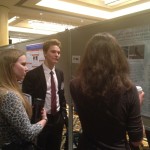 That evening research student Luke Andrew presented his poster entitled “Use of Torpor by a High- and Mid-Elevation Hummingbird Species in Southeastern Arizona.” The poster summarized data collected this past summer in collaboration with Dr. Susan Wethington of the Hummingbird Monitoring Network on patterns of torpor (nighttime hypothermia) use in broad-tailed (Selasphorus platycerus) and broad-billed (Cynanthus latirostris) hummingbirds. Even though they put Luke back in a dark corner of the exhibit hall he had good traffic including some well known physiologists.
That evening research student Luke Andrew presented his poster entitled “Use of Torpor by a High- and Mid-Elevation Hummingbird Species in Southeastern Arizona.” The poster summarized data collected this past summer in collaboration with Dr. Susan Wethington of the Hummingbird Monitoring Network on patterns of torpor (nighttime hypothermia) use in broad-tailed (Selasphorus platycerus) and broad-billed (Cynanthus latirostris) hummingbirds. Even though they put Luke back in a dark corner of the exhibit hall he had good traffic including some well known physiologists.
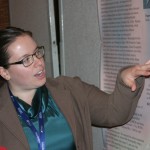 The lab’s final two poster presentations occurred on Sunday. Research student Katie Langland presented her study entitled “Use of Infrared Thermography to Measure Body-Surface Heat Dissipation in Free-Living Hummingbirds.” In this study, also done in collaboration with Dr. Susan Wethington, Katie explored the relationship between environmental temperature and surface heat loss in hummingbirds. Katie had a busy night as there steady stream of attendees interested in what she had to say.
The lab’s final two poster presentations occurred on Sunday. Research student Katie Langland presented her study entitled “Use of Infrared Thermography to Measure Body-Surface Heat Dissipation in Free-Living Hummingbirds.” In this study, also done in collaboration with Dr. Susan Wethington, Katie explored the relationship between environmental temperature and surface heat loss in hummingbirds. Katie had a busy night as there steady stream of attendees interested in what she had to say.
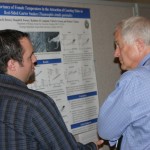 Finally, former research student and current adjunct instructor in the Biology Department Sean Powers agreed to help the lab out by analyzing some infrared thermography data and presented a poster entitled “The Importance of Female Temperature in the Attraction of Courting Males in Red-Sided Garter Snakes (Thamnophis sirtalis parietalis).” Sean’s data cast doubt on a long-standing hypothesis that males are more attracted to cold females. The basis of this hypothesis is that when females emerge from the den they are cold and likely to be unmated.
Finally, former research student and current adjunct instructor in the Biology Department Sean Powers agreed to help the lab out by analyzing some infrared thermography data and presented a poster entitled “The Importance of Female Temperature in the Attraction of Courting Males in Red-Sided Garter Snakes (Thamnophis sirtalis parietalis).” Sean’s data cast doubt on a long-standing hypothesis that males are more attracted to cold females. The basis of this hypothesis is that when females emerge from the den they are cold and likely to be unmated.


